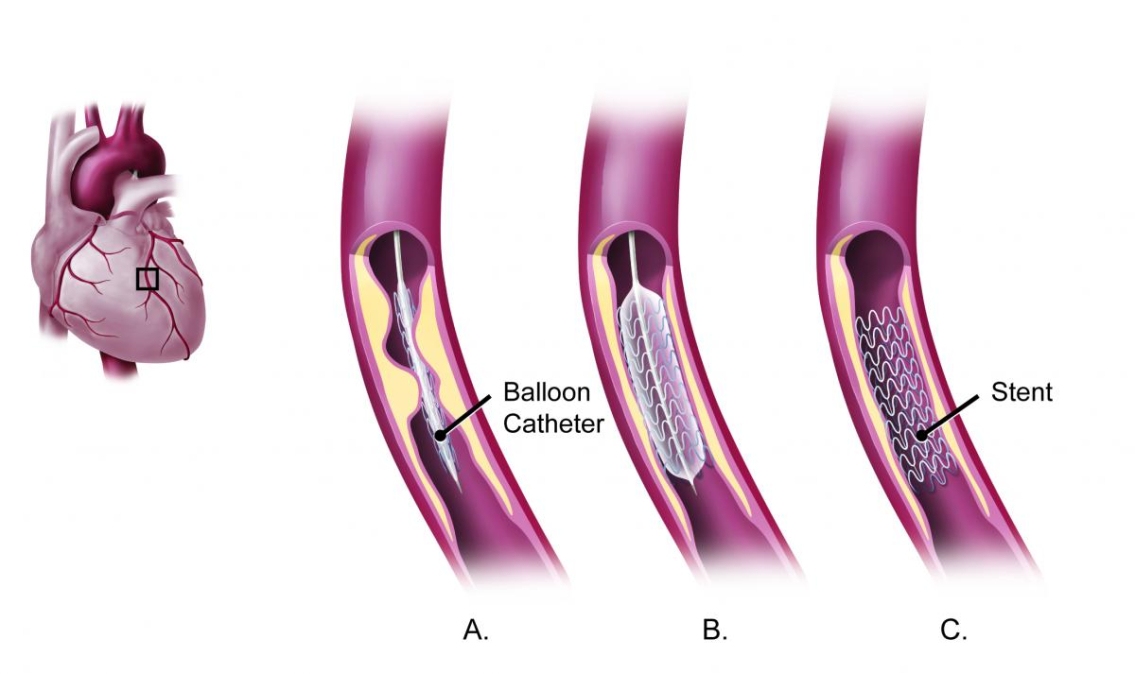Purpose
Coronary artery disease is caused by the buildup of atherosclerotic plaques within the walls of the coronary arteries causing them to become narrowed and disrupting the flow of blood.
An angioplasty is used to widen areas within coronary arteries that have become narrowed. In this procedure, a thin flexible tube (catheter) which has a small inflatable balloon at the tip is positioned within the narrowed section of the artery. The balloon is inflated for a short period of time to push the plaque back against the wall of the artery so that blood can flow better.

An angioplasty is used to widen the narrowing in arteries of your heart without surgery. It is similar to a cardiac catheterization. Both are done in the catheterization lab. In most cases, an angioplasty will provide immediate relief from the symptoms of coronary artery disease and will allow you to be more active and comfortable.
A stent is usually used to prevent the artery from narrowing again. A stent is a small metal mesh tube that is permanently implanted into the narrowed part of the artery. The purpose of the stent is to keep the artery from blocking again.
Description
Note: Please bring your Health Card and all of your medications in their original containers along with any vitamins or supplements that you take. Many of our patients also find it helpful to bring:
- A family member or friend to take notes or ask questions
- A list of your own questions to ensure that you have all the information
Before you have a coronary angiogram, expect to have:
- An assessment by a nurse that includes measuring your blood pressure and other vital signs
- A session to teach you about the procedure
- Review and signing of the consent form
- Blood tests and an ECG
- Specific instructions about your medications
- Cleaning and preparation of a small area of both groins or your wrist
Immediately before the procedure, you will be taken to the cardiac catheterization lab.
- You will be given medication to help you relax, but you will be awake during the procedure so that you can follow instructions from the doctor and nurses.
- The doctor will administer freezing to your groin or your wrist.
- A thin, flexible tube (balloon catheter) with a small inflatable balloon on the end is inserted. If a stent is being used, it will be placed over the balloon before the catheter is inserted.
- X-ray pictures will be taken and a special dye will be injected through the catheter to identify the narrowed sections or blockages in the arteries in your heart.
- The balloon catheter is guided to the narrowed section of the artery.
- The balloon is inflated for a short period of time to push the plaque back against the wall of the artery and implant the stent.
- Once the balloon has been deflated and removed, the stent stays in place, permanently holding the blood vessel open and improving blood flow.
- It is not unusual to experience some chest pain. Inform the nurse if you experience any discomfort or have concerns.
- The time for the procedure in the lab is usually 30 to 90 minutes.
After your procedure, you will be transferred back to the Day Unit.
- The nurse will frequently check your pulse, blood pressure, pulses in your feet or wrist, and the puncture site.
- You will be on bedrest for an hour if you had the catheter inserted in your wrist or up to six hours if the catheter was inserted in your groin. During this time, you may sleep or rest.
- If you experience discomfort, let the nurse know. You can be repositioned with help.
- If you are hungry, you will be given a snack.
- You will be encouraged to drink fluids to help flush the dye out of your kidneys. Ask your nurse for help if you need to go to the bathroom.
- The doctor will discuss the results of your angioplasty with you and make recommendations for any new treatments or medications at that time.
- Before you are discharged, you will be encouraged to walk around to ensure that you are feeling okay.
Patient instructions
If you are scheduled and waiting for an angioplasty and you have questions or concerns, contact the Regional Cardiac Care Coordinator at 613-696-7061.
Please make arrangements for transportation home on discharge. You are not allowed to drive yourself. Discharge will take place approximately five to six hours after your procedure.
If you live a considerable distance from the Heart Institute, check with the doctor to see if you should stay close to the hospital the night of discharge. Arrangements for accommodations should be made in advance.
Additional info
Patient Resources
Angioplasty in not a cure for coronary artery disease. Coronary artery disease needs lifelong management:
- Cardiac Catheterization Patient Guide
- Coronary Artery Disease Patient Guide
- Coronary Artery Disease - Treatment options: A Heart Team Approach (PDF)
- Getting regular physical activity
- Quitting smoking

